 Thanks to a generous grant from the Silvano Toti Foundation, the Hercules Room of Rome’s Palazzo Venezia is now getting a much-needed restoration. The Palazzo Venezia was built in the middle of the 15th century at the behest of Cardinal Pietro Barbo, the future Pope Paul II. The stones used to build it were taken from the Colosseum, just a short jaunt to the southeast. One of the first buildings in Rome with Renaissance architectural elements, the Palazzo Venezia would outlive many later Renaissance buildings which were damaged or destroyed by the troops of the Holy Roman Emperor during the Sack of Rome in 1527.
Thanks to a generous grant from the Silvano Toti Foundation, the Hercules Room of Rome’s Palazzo Venezia is now getting a much-needed restoration. The Palazzo Venezia was built in the middle of the 15th century at the behest of Cardinal Pietro Barbo, the future Pope Paul II. The stones used to build it were taken from the Colosseum, just a short jaunt to the southeast. One of the first buildings in Rome with Renaissance architectural elements, the Palazzo Venezia would outlive many later Renaissance buildings which were damaged or destroyed by the troops of the Holy Roman Emperor during the Sack of Rome in 1527.
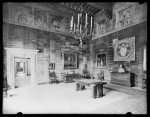 In 1564 the Pope granted use of the palace to the Most Serene Republic of Venice for its embassy. From the end of the 18th century until World War I, it was the seat for the Austrian ambassador to the Holy See. At war with Austria-Hungary, the Italian state claimed it in 1916. Benito Mussolini claimed the Map Room in the Palazzo Venezia for his office and many a newsreel captures him speechifying from the balcony to adoring crowds below. He even built a secret bunker in the basement.
In 1564 the Pope granted use of the palace to the Most Serene Republic of Venice for its embassy. From the end of the 18th century until World War I, it was the seat for the Austrian ambassador to the Holy See. At war with Austria-Hungary, the Italian state claimed it in 1916. Benito Mussolini claimed the Map Room in the Palazzo Venezia for his office and many a newsreel captures him speechifying from the balcony to adoring crowds below. He even built a secret bunker in the basement.
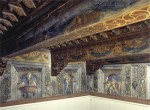 Today the palace is a national museum, home to thousands of works of art. While the building was modified repeatedly over five centuries, it still holds many original decorations from the 15th century. The Hercules Room is perhaps the most sterling example, with its frescoes depicting the Labours of Hercules and elaborately carved and painted wooden ceiling. Located on the piano nobile (the first floor where the receiving and private rooms of the noble family were), the Hercules Room was at one end of the
Today the palace is a national museum, home to thousands of works of art. While the building was modified repeatedly over five centuries, it still holds many original decorations from the 15th century. The Hercules Room is perhaps the most sterling example, with its frescoes depicting the Labours of Hercules and elaborately carved and painted wooden ceiling. Located on the piano nobile (the first floor where the receiving and private rooms of the noble family were), the Hercules Room was at one end of the 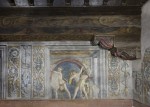 Pietro Barbo’s apartment. Once he was elevated to the Throne of Saint Peter and got new digs in the Vatican, the room was used to store pontifical vestments. The highest part of the walls are decorated with eight panels displaying scenes from the Labours — Hercules and the Nemean lion, Hercules and Antaeus, Hercules with one of Geryon’s head of cattle, Hercules and Geryon, Hercules slaying the dragon Ladon, guardian of the Apples of the Hesperides, Hercules and the Ceryneian Hind, Hercules and the Stymphalian Birds, and lastly, Hercules and the centaur Nessus. Frescoed
Pietro Barbo’s apartment. Once he was elevated to the Throne of Saint Peter and got new digs in the Vatican, the room was used to store pontifical vestments. The highest part of the walls are decorated with eight panels displaying scenes from the Labours — Hercules and the Nemean lion, Hercules and Antaeus, Hercules with one of Geryon’s head of cattle, Hercules and Geryon, Hercules slaying the dragon Ladon, guardian of the Apples of the Hesperides, Hercules and the Ceryneian Hind, Hercules and the Stymphalian Birds, and lastly, Hercules and the centaur Nessus. Frescoed 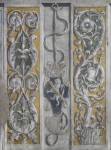 between the Labour panels are little putti, garlands, architectural motifs and the coat of arms of Pope Paul II.
between the Labour panels are little putti, garlands, architectural motifs and the coat of arms of Pope Paul II.
Some past scholars have attributed to the great master of perspective and antique motifs Andrea Mantegna who famously frescoed the exquisite Camera degli Sposi in the Ducal Palace of Mantua. Others attributed them to an unnamed artist at the pontifical court. The artist remains unknown today, although scholars believe he was probably from northern Italy. The restoration and study of the frescoes will give experts the opportunity to revisit the authorship question.
 The restoration is expected to take four months, from July to October. They will be a busy four months. On the agenda are the cleaning of the frescoes, the strengthening of the plaster layer and paint layers, revising past restorations and disinfecting and disinfesting the wood ceiling. Restorers will also investigate the techniques used in the original painting of the frescoes.
The restoration is expected to take four months, from July to October. They will be a busy four months. On the agenda are the cleaning of the frescoes, the strengthening of the plaster layer and paint layers, revising past restorations and disinfecting and disinfesting the wood ceiling. Restorers will also investigate the techniques used in the original painting of the frescoes.
Restorers Isabella Righetti and Rita Ciardi told ANSA that renovation work is urgently needed because of repeated and heavy-handed work carried out in the past. […]
The restorers also said dried pigments used in previous restoration works hid the artworks’ original colors.
“By cleaning them, we hope to rediscover the polish of the paintings, which were supposed to look like large windows that were open towards the outside”.
Free guided tours of the room will be offered to the public starting in September so visitors will have the chance to view the restorers at work.
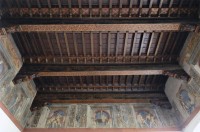
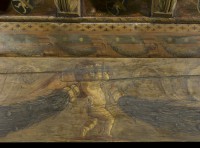

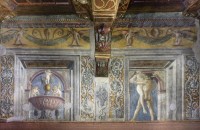
“the Pope granted use of the palace to the Most Serene Republic of Venice for its embassy.” I once saw a lament that the American Constitution used the dismally dull “President” rather than the vivid “Doge”.